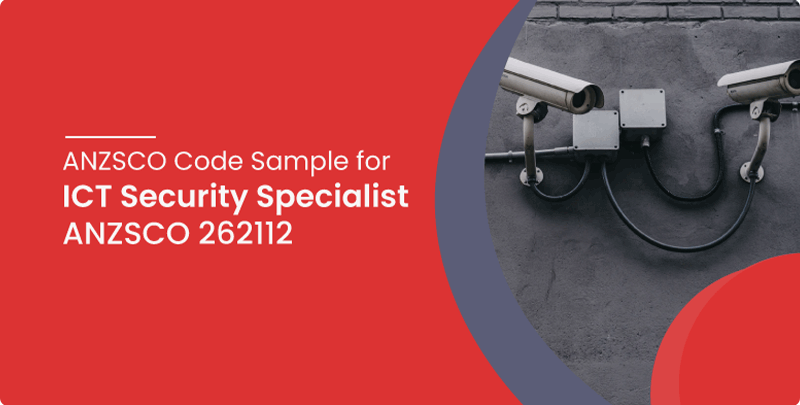Get Free Consultation
ANZSCO Code
ANZSCO 262112 ICT Security Specialist
ICT Security Specialist establishes, manages and administers an organization’s ICT security policy and procedures to ensure preventive and recovery strategies are in place, and minimize the risk of internal and external security threats. Security specialist’s co-ordinate and implement security measures to protect computer systems from unauthorized access. This is a critical role, which is responsible for protecting an organization’s information.
Skill Level
Level 1 or Equivalent
Specializations
Information Technology Security Manager
Skills Assessment Authority
ACS (Australian Computer Society)
Alternative Titles
Security Administrator

On the Occupation Lists:
- Combined Skilled Occupations List (STSOL MLTSSL)
- Medium Long Term Strategic Skills List (MLTSSL)
- RSMS Occupations List (RSMSL)
Not on the Occupation Lists:
- Labour Market Testing Required for 457 List (LMTL)
- Short-Term Skilled Occupation List (STSOL)
Visa Provision
As the occupation features on the Short-term Skilled Occupation List (STSOL), it is possible to apply for a Skilled Nominated 190 visa or a Skilled Regional Nominated 489 visa. If you are employed in this occupation and you wish to pursue a GSM visa, you will be required to apply for state nomination in order to move to Australia.
Note: *While the occupation is on the STSOL it remains a possibility that no states currently have a demand for people in that profession. The online assessment only lists occupations which are currently in demand by a state or territory in Australia, so if the occupation does not appear on the online assessment you should consider seeking an employer sponsor in Australia.
Unit Group: 2621 Database and Systems Administrators, and ICT Security Specialist
The job of an ICT security specialist in Australia is to plan, develop, maintain, manage and administer an organization's database management systems, operating systems and security policies and procedures to ensure optimal database and system integrity, security, backup, reliability and performance.
Skill Level
Most occupations in this unit group have a level of skill commensurate with a bachelor degree or higher qualification. At least five years of relevant experience and/or relevant vendor certification may substitute for the formal qualification. In some instances, relevant experience and/or on-the-job training may be required in addition to the formal qualification (ANZSCO Skill Level 1).
English Requirement
- IELTS result with a minimum score of 6 (L, R, W), 7 in speaking and 7 overall;
- OET result with a minimum grade B in all sections;
- TOEFL iBT with a minimum score (L:12 R:13 W:21 S:23 overall L93);
- PTE Academic with a min score of 50 (L, R, W), 65 in speaking and 65 overall
Exceptions
- Australian Graduate exceptions apply in some states/territories
- Priority Skilled Lists may apply a specific requirement in some states
- Countries exempt from submitting IELTS or OET include the UK; Canada; New Zealand; US; and Ireland Where mandatory licensing or registration is required you must demonstrate a level of English either sufficient to meet licensing / registration or a minimum IELTS, or equivalent, whichever is higher.
Occupations in this Group
- 262111 Database Administrator
- 262112 ICT Security Specialist
- 262113 Systems Administrator
Tasks to Perform
- Designing and maintaining database architecture, data structures, tables, dictionaries and naming conventions to ensure the accuracy and completeness of all data master files
- Performing the operational establishment and preventive maintenance of backups, recovery procedures, and enforcing security and integrity controls
- Implementing and administering database documentation, guidelines, policies and procedures
- Testing database systems and upgrades, such as debugging, tracking, reproduction, logging and resolving all identified problems, according to approved quality testing scripts, procedures and processes
- Accepting responsibility for the processes, procedures and operational management associated with system security and disaster recovery planning
- Liaising with security vendors, suppliers, service providers and external resources; analyzing, recommending, installing and maintaining software security applications; and monitoring contractual obligations, performance delivery and service level agreements
- Troubleshooting and providing service support in diagnosing, resolving and repairing server-related hardware and software malfunctions, encompassing workstations and communication infrastructure
- Preparing and maintaining documentation, policies and instructions, and recording and detailing operational procedures and system logs
- Ensuring that the design of computer sites allows all components to fit together and work properly, and monitoring and adjusting the performance of networks
- Continually surveying the current computer site to determine future network needs and making recommendations for enhancements in the implementation of future servers and networks
Closely Related Core ICT Units
- Computer forensics
- Data Encryption
- Database design
- Database implementation
- Database Management Systems – (Relational Database, Object Oriented Database, RDBMS)
- Information security
- Information Systems security
- Internet and the Web
- Internet forensics
- Network security
- Operating systems – (Unix, Linux, Xenix, Network OS)
- Web security
Brief Description
Controls typically include physical isolation of assets in a secure area, protected by a defined security perimeter, with appropriate security barriers and entry controls. It is the policy or the procedures to ensure preventive and recovery strategies in order to minimize the risk of internal and external security problems. computers safety is the main motto so the data and information are kept secured, it can include the data security and integrity, intrusions and anomalous traffic. the attacker might be able to erase all log file on a compromised host, network-based evidence for a forensic. Controls typically include physical isolation of assets in a secure area, protected by a defined security perimeter, with appropriate security barriers and entry controls.
Additional Closely Related Core ICT Units
- Client-Server Technology
- Computer networks
- Critical Path Method
- Data Communications
- Data policy
- Data structures
- Distributed Systems
- File Processing
- Introduction to ICT – (Introduction to Computer Science, Computer Theory, Introduction to Business Computing, Computer Science I)
- Project Management
- Quality management – (Quality Assurance, Software Quality)
- Testing strategies and methods


